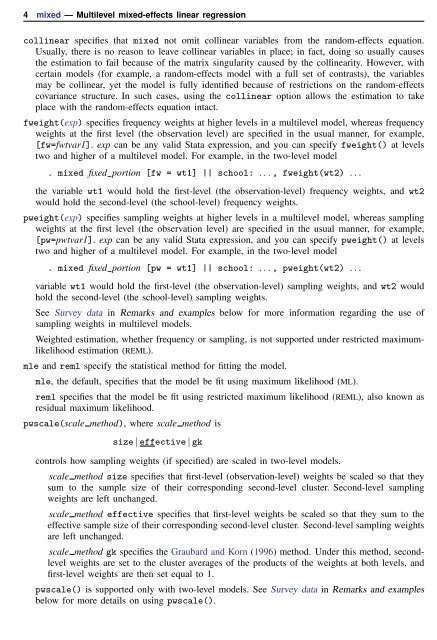mixed - Stata
mixed - Stata
mixed - Stata
You also want an ePaper? Increase the reach of your titles
YUMPU automatically turns print PDFs into web optimized ePapers that Google loves.
4 <strong>mixed</strong> — Multilevel <strong>mixed</strong>-effects linear regression<br />
collinear specifies that <strong>mixed</strong> not omit collinear variables from the random-effects equation.<br />
Usually, there is no reason to leave collinear variables in place; in fact, doing so usually causes<br />
the estimation to fail because of the matrix singularity caused by the collinearity. However, with<br />
certain models (for example, a random-effects model with a full set of contrasts), the variables<br />
may be collinear, yet the model is fully identified because of restrictions on the random-effects<br />
covariance structure. In such cases, using the collinear option allows the estimation to take<br />
place with the random-effects equation intact.<br />
fweight(exp) specifies frequency weights at higher levels in a multilevel model, whereas frequency<br />
weights at the first level (the observation level) are specified in the usual manner, for example,<br />
[fw=fwtvar1]. exp can be any valid <strong>Stata</strong> expression, and you can specify fweight() at levels<br />
two and higher of a multilevel model. For example, in the two-level model<br />
. <strong>mixed</strong> fixed_portion [fw = wt1] || school: . . . , fweight(wt2) . . .<br />
the variable wt1 would hold the first-level (the observation-level) frequency weights, and wt2<br />
would hold the second-level (the school-level) frequency weights.<br />
pweight(exp) specifies sampling weights at higher levels in a multilevel model, whereas sampling<br />
weights at the first level (the observation level) are specified in the usual manner, for example,<br />
[pw=pwtvar1]. exp can be any valid <strong>Stata</strong> expression, and you can specify pweight() at levels<br />
two and higher of a multilevel model. For example, in the two-level model<br />
. <strong>mixed</strong> fixed_portion [pw = wt1] || school: . . . , pweight(wt2) . . .<br />
variable wt1 would hold the first-level (the observation-level) sampling weights, and wt2 would<br />
hold the second-level (the school-level) sampling weights.<br />
See Survey data in Remarks and examples below for more information regarding the use of<br />
sampling weights in multilevel models.<br />
Weighted estimation, whether frequency or sampling, is not supported under restricted maximumlikelihood<br />
estimation (REML).<br />
mle and reml specify the statistical method for fitting the model.<br />
mle, the default, specifies that the model be fit using maximum likelihood (ML).<br />
reml specifies that the model be fit using restricted maximum likelihood (REML), also known as<br />
residual maximum likelihood.<br />
pwscale(scale method), where scale method is<br />
size | effective | gk<br />
controls how sampling weights (if specified) are scaled in two-level models.<br />
scale method size specifies that first-level (observation-level) weights be scaled so that they<br />
sum to the sample size of their corresponding second-level cluster. Second-level sampling<br />
weights are left unchanged.<br />
scale method effective specifies that first-level weights be scaled so that they sum to the<br />
effective sample size of their corresponding second-level cluster. Second-level sampling weights<br />
are left unchanged.<br />
scale method gk specifies the Graubard and Korn (1996) method. Under this method, secondlevel<br />
weights are set to the cluster averages of the products of the weights at both levels, and<br />
first-level weights are then set equal to 1.<br />
pwscale() is supported only with two-level models. See Survey data in Remarks and examples<br />
below for more details on using pwscale().
















